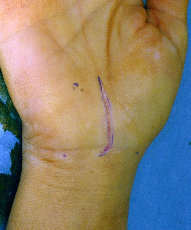A carpal tunnel decompression is the surgical treatment for carpal tunnel syndrome. The surgery involves decompressing the carpal tunnel by dividing the flexor retinaculum, which is the ligament that forms the roof of the carpal tunnel, and it is one of the commonest hand operations performed.
Before your surgery:
You will receive a letter with the details of the date and time of your operation in the post. This will provide you with information of what to do and expect during your treatment. Some hospitals now routinely have pre-operative assessment clinics where you will see a nurse and any medical issues explored. You will also be given advice on what post-operative painkillers (analgesia) is likely to be required, which is usually paracetamol.
A carpal tunnel decompression is a relatively minor operation which is usually performed using local anaesthesia as a day case. Because the operation is done under local anaesthetic there are usually no restrictions on eating or drinking before surgery, although you should check with your surgeon to be sure.
On the day of your surgery:
You should arrive on the ward at your allotted time. Your preoperative letter will tell you whether you require to bring any specific items, although it is common requested that you bring a dressing gown and slippers.
The nurses will complete some paperwork with you and check your medication. Your surgeon will also visit and ensure that you understand what is going to happen and answer any questions that you may have. You will sign a consent form and an arrow will be put on your arm using a felt tip pen (this is routine practice to identify the correct side that will be operated on).
Before your surgery your surgeon will inject the local anaesthetic to numb the skin. This is usually done in the operating theatre, but some surgeons may inject this on the ward. Many patients worry that this will hurt, but generally if it is administered carefully the injection is not usually painful.
 Once the anaesthetic has worked your surgery can take place. The skin is cleaned with antiseptic fluid painted on the skin and sterile towels are used to cover the area. Some surgeons will use a tourniquet to prevent blood from entering the arm. You will be aware of a tight bandage on your upper arm, which is similar to the cuff used when you have your blood pressure taken. On average the operation takes approximately 10 minutes and it is not usually painful. You may be aware of tugging and pulling sensations around your wrist but this will not hurt. If you have a personal music player you are welcome to listen to this during the operation.
Once the anaesthetic has worked your surgery can take place. The skin is cleaned with antiseptic fluid painted on the skin and sterile towels are used to cover the area. Some surgeons will use a tourniquet to prevent blood from entering the arm. You will be aware of a tight bandage on your upper arm, which is similar to the cuff used when you have your blood pressure taken. On average the operation takes approximately 10 minutes and it is not usually painful. You may be aware of tugging and pulling sensations around your wrist but this will not hurt. If you have a personal music player you are welcome to listen to this during the operation.
After the operation a bandage will be applied and you will return to the ward where you can have a welcome drink and something to eat.
After your surgery:
Once the nurses are happy you will be able to go home. Generally it will expected that someone accompanies you home as it is not advisable for you to drive or be left alone. You will be given a sling so that you can keep your arm elevated for a day or two and you will be given an appointment for your next outpatient clinic.
It is not normally a painful operation, but if you experience any discomfort then you should take some of your analgesic medication. You will need to keep your bandage dry and this will remain for up to 2 weeks. When you attend your follow up appointment your stitched will be removed, although some surgeons like Mr Farnell use dissolvable stitches which do not need removing. It is unusual to require physiotherapy after a carpal tunnel decompression.
You will be provided with contact details which you can use if you have any concerns or problems.
Complications:
Complications are uncommon and usually minor.
- Scar tenderness - this is the most commonly experienced problem. It is a nuisance and usually resolves completely. Massaging the scar with a moisturiser helps to settle this.
- Wound infection - seen in up to 1% of cases
- finger stiffness - uncommon and best avoided by keeping the fingers moving
- median nerve injury has been described but this is very rare.
Prognosis after surgery:
Night-time and sensory symptoms usually resolve immediately or shortly after surgery. However, sensation may not return to normal especially if the hand was constantly numb before surgery.
The surgical scar heals well and once the redness and lumpiness has resolved it fades and looks like a skin crease.